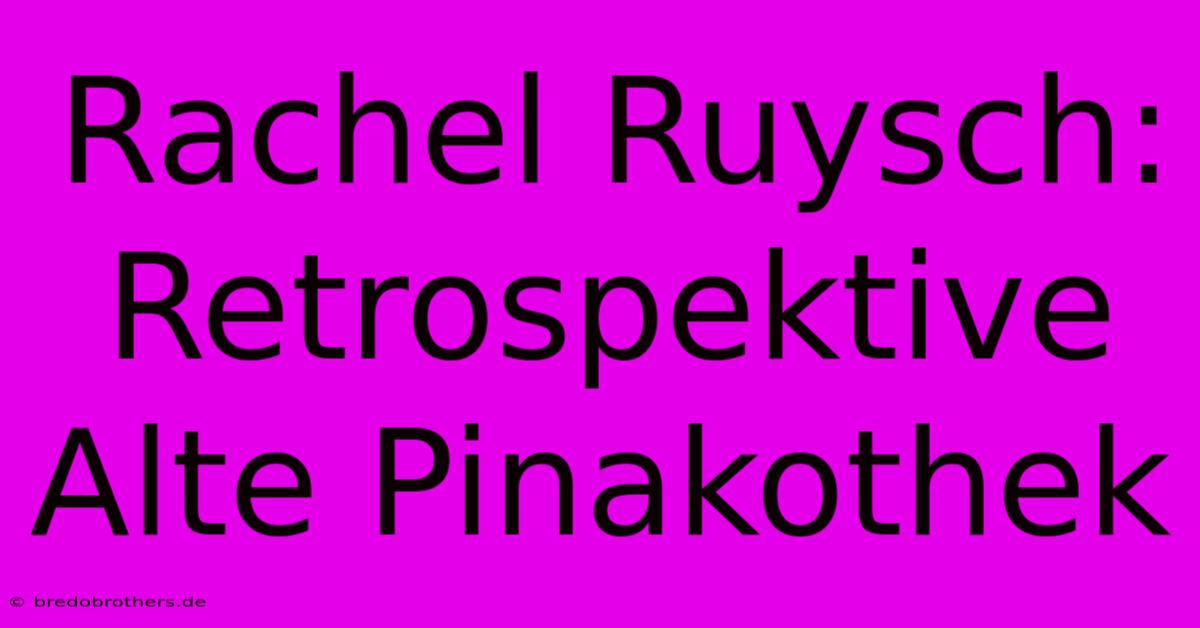Rachel Ruysch: Retrospektive Alte Pinakothek

Discover more detailed and exciting information on our website. Click the link below to start your adventure: Visit Best Website Rachel Ruysch: Retrospektive Alte Pinakothek. Don't miss out!
Table of Contents
Rachel Ruysch: A Retrospective at the Alte Pinakothek – My Unexpectedly Moving Experience
Okay, so, full disclosure: I'm not exactly a huge art history buff. My knowledge of, say, Baroque still lifes mostly involved vaguely remembering something about fruit bowls from high school. But a friend dragged me to the Rachel Ruysch retrospective at the Alte Pinakothek in Munich, and wow, was I blown away. Seriously, blown. Away.
I went in expecting…well, pretty flowers, right? I mean, that's what everyone says about Ruysch. "Oh, she's the flower painter." Yeah, well, it's way more than that. It's so much more.
<h3>Beyond the Pretty Pictures: Ruysch's Mastery</h3>
First off, the sheer detail. I mean, I'm talking about tiny, almost microscopic detail. You could get lost in the delicate veining of a leaf, the subtle gradations of color in a petal. Seriously, I spent like fifteen minutes just staring at one single carnation. My friend thought I was having a stroke. I wasn't. I was just mesmerized.
Ruysch wasn't just painting pretty pictures, though. She was creating these incredibly complex ecosystems, miniature worlds teeming with life. Butterflies, insects, snails—they're all there, woven into these vibrant arrangements. It’s like she’s captured a moment in time, preserving the fleeting beauty of nature with incredible skill. And, I'm no art critic, but the way she played with light and shadow...amazing. It’s almost three-dimensional.
<h3>My Biggest Mistake (and What I Learned)</h3>
My biggest mistake? Going in thinking it would be a quick trip. I totally underestimated the impact of her work. I didn't allow myself enough time to truly appreciate each painting. I rushed through some of the early pieces, feeling a bit overwhelmed by the sheer volume of detail.
Lesson learned: Plan for plenty of time! Don't just skim the surface; take your time, let yourself get lost in the detail, and absorb the atmosphere.
<h3>Practical Tips for Your Visit</h3>
-
Go on a weekday: It’ll be less crowded, and you can really savor the experience. Weekends are a total zoo – I can't stress this enough.
-
Download the museum app: It provides extra context and information that will enhance your understanding of Ruysch’s techniques and the historical context of her work. I wish I'd done this. It would have helped a bunch.
-
Take your time: Don't rush! Seriously. I repeat this because it is super important. Spend time studying individual pieces. Think about the meaning and symbolism; how she incorporated elements of vanitas in several works – the reminder of life's fleeting nature, usually expressed through wilting flowers or dead insects.
-
Check the museum website for special events: They often have lectures or guided tours, enriching your appreciation of her art.
<h3>The Lasting Impression</h3>
The retrospective wasn't just about pretty flowers; it was about the artistry, the technical skill, and the power of observation. Ruysch's work transcends its time period. Her paintings are more than just botanical studies; they're meditations on beauty, transience, and the intricate tapestry of life. It was honestly one of the most unexpectedly moving museum experiences I’ve ever had. Go see it if you can. You won't regret it. Trust me. I swear, you'll be as hooked as I am. I’m already planning my return trip!

Thank you for visiting our website wich cover about Rachel Ruysch: Retrospektive Alte Pinakothek. We hope the information provided has been useful to you. Feel free to contact us if you have any questions or need further assistance. See you next time and dont miss to bookmark.
Featured Posts
-
Feux Amour S26 Folge 90 Online
Nov 27, 2024
-
Zalando Aktie Verlust 5 Jahre
Nov 27, 2024
-
Deutschland Rohstoffe Wo Bleiben Die Rekordgewinne
Nov 27, 2024
-
Euro Millions Gewinner 212 Millionen Nutzt Das Keyword Und Den Gewinn Klar Verstaendlich
Nov 27, 2024
-
Lukeba Und Leipzigs Schlechter Tag
Nov 27, 2024
